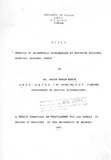PROFILE OF SALMONELLA TYPHIMURIUM AT KENYATTA NATIONAL HOSPITAL NAIROBI, KENYA
| dc.contributor.author | Mizra, Nazir | |
| dc.date.accessioned | 2017-09-28T12:58:29Z | |
| dc.date.available | 2017-09-28T12:58:29Z | |
| dc.date.issued | 1991 | |
| dc.identifier.uri | http://hdl.handle.net/11295/101072 | |
| dc.description.abstract | Salmonella typhimurium infections at Kenyatta National Hospital (KNH) are being isolated more frequently than Salmonella typhi. There has been a persistent rise in the isolation of S.typhimurium from blood, stools and cerebrospinal fluids (CSF) since 1970, with reports of minor outbreaks in 1972 and 1974. A major outbreak occurred in 1985 which resulted in closure of the paediatric observation wards (POW) the main admission area for children. Renovation measures in POW improved the situation for only a short time. S.typhimurium reappeared soon after reopening these wards. Over - crowding with resultant poor hygiene is one of the contributory factors to infections with S.typhimurium | en_US |
| dc.language.iso | en | en_US |
| dc.publisher | University of Nairobi | en_US |
| dc.rights | Attribution-NonCommercial-NoDerivs 3.0 United States | * |
| dc.rights.uri | http://creativecommons.org/licenses/by-nc-nd/3.0/us/ | * |
| dc.subject | Salmonella typhimurium | en_US |
| dc.title | PROFILE OF SALMONELLA TYPHIMURIUM AT KENYATTA NATIONAL HOSPITAL NAIROBI, KENYA | en_US |
| dc.type | Thesis | en_US |
| atmire.cua.enabled |



